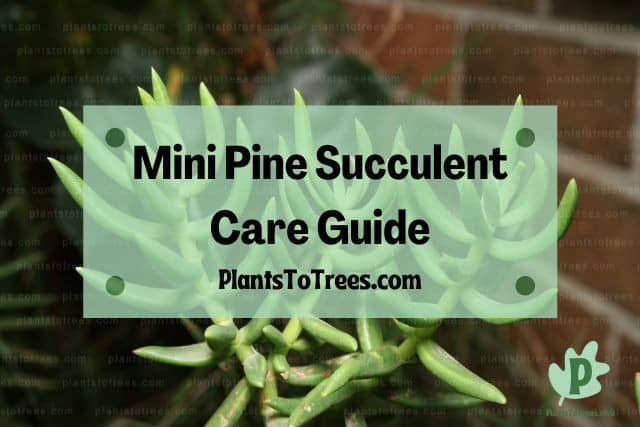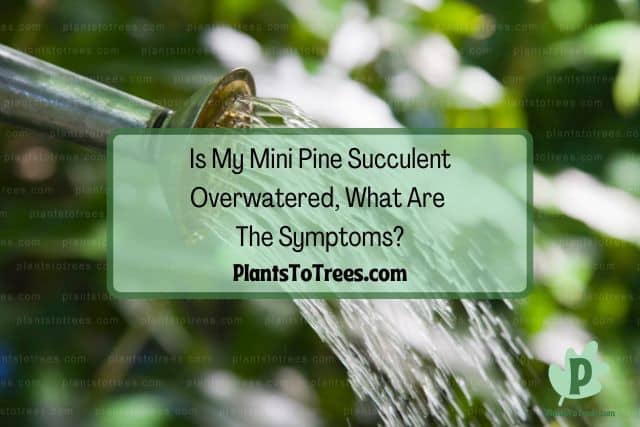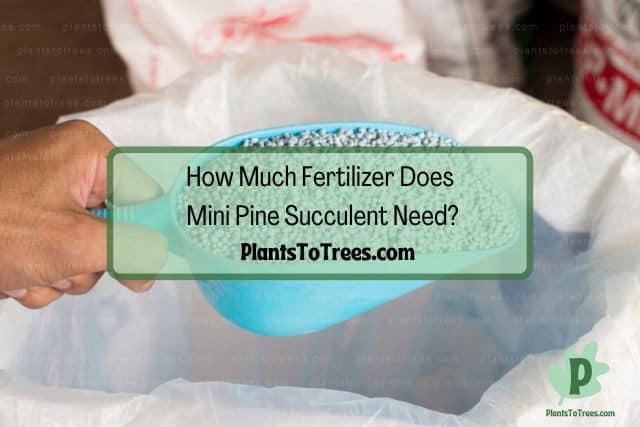Succulents are often some of the easiest plants to grow, and the mini pine succulent is no exception. This low maintenance plant may look similar in many ways to a small pine tree, but it is actually a succulent that is often grown as a bonsai tree. Like other succulents, the mini pine doesn’t need much watering and is drought tolerant. Additionally, the mini pine succulent can handle some shade and doesn’t deal with many pests or diseases.

Learning about the mini pine succulent care guide is the best way to ensure you are giving this plant the conditions it needs to thrive. This means making sure it is growing in the right type of soil, correct temperatures, proper amount of watering, and out of direct light.
Other Names Of Mini Pine Succulent
Despite it having the word pine in its name, the mini pine isn’t a pine at all and is instead a succulent. But does this plant go by any other names?
Mini pine succulent is most well known by that name, but it is sometimes called a mini pine tree. Its scientific name is Crassula tetragona, and it is native to South Africa. This succulent is often used as a bonsai plant.
This plant features small but stunning green leaves that have a spiky appearance that resembles pine needles. These leaves are on vertical branches that are upright. It can grow around 4 feet tall in its native habitat. During late spring and early summer, the mini pine succulent can produce white blooms.
Frost Tolerance And USDA Hardiness Zones Of Mini Pine Succulent
Knowing the frost tolerance and hardiness zones of the mini pine succulent will help you better care for this stunning plant. It will also help prevent you from accidentally killing the plant by setting it outside when the weather is too cold.
The mini pine succulent is not frost or cold tolerant, and can only grow outdoors in USDA hardiness zones 9 to 11. If you grow it outdoors outside of these hardiness zones, then the plant will end up being an annual, which means it won’t grow once frost kills it off.
How Many Hours Of Sunlight Does Mini Pine Succulent Need?

Don’t be fooled by this easy-going succulent. Just because it can tolerate some low light conditions doesn’t mean you should stick it in a dark room.
Mini pine succulents need, on average, 4 to 6 hours of sunlight every day. An east, west, or south-facing window is ideal for this houseplant. However, you may have to move the succulent to various areas in your home until you find the right location.
Mini Pine Succulent Needs Direct Or Indirect Sunlight?
One of the great things about the mini pine succulent is that it can handle partial shade to full sun. But what about direct or indirect sunlight?
Mini pine succulents should be kept out of direct sunlight as it can burn and scorch the plant’s leaves. This will cause the affected foliage to turn brown and discolored, and it may even fall off the plant’s stems.
Is Mini Pine Succulent An Indoor Plant, Outdoor Plant, Or Both?
Whether or not a plant is an indoor or outdoor plant solely depends on whether or not it is cold and frost tolerant, as well as what hardiness zones it can grow in.
The mini pine succulent is most often grown indoors as a houseplant since this plant requires warm temperatures throughout the entire year. With that said, however, it can grow outdoors if you live in USDA plant hardiness zones 9 to 11.
What Are The Indoor Lighting Requirements for a Mini Pine Succulent?

The lighting requirement for houseplants can sometimes be different than that of plants grown outside.
If you are growing the mini pine succulent indoors, you will need to provide it with 4 to 6 hours of indirect sun. This will result in the best growth. With that said, however, this succulent can also tolerate partial shade and some lower light conditions.
If you notice the plant is a bit limp and isn’t growing, try increasing the amount of light the succulent is receiving. When a mini pine doesn’t get enough light, it can cause the plant to become a bit limp, leaves to start to look dull, and its growth will be stunted.
What Are The Outdoor Lighting Requirements for a Mini Pine Succulent?
With the mini pine succulent, its outdoor lighting requirements are the same as if you were growing the plant indoors.
Mini pine succulents growing outdoors need 4 to 6 hours of sunlight a day. The light should be indirect, since direct light can damage the plant’s foliage. The plant can also grow in partial shade, though its growth won’t be as fast or as strong as if you gave the plant the ideal amount of sun.
What Soil Requirements Does Mini Pine Succulent Need?

Some people are not aware how important the soil is for the overall health and wellness of plants. For example, not providing the mini pine succulent with the right type of soil can increase the chance of fungal diseases.
Mini pine succulents need soil that drains well and isn’t compact. A mixture of cactus and succulent potting soil mixed with mineral grit, such as perlite, coarse sand, or pumice works well for this plant. Use a ratio of 70 percent mineral grit and 50 percent soil for the best results.
How Much Water Does Mini Pine Succulent Need?
Watering succulents can be difficult since these types of plants are well-known for their ability to go long periods of time without hydration.
As with the other succulents, the mini pine doesn’t require a whole lot of watering, and you will usually only need to water once every 10 or so days. However, this can vary based on several factors so you should always test the soil moisture level before watering.
Is My Mini Pine Succulent Overwatered, What Are The Symptoms?

Overwatering is a serious problem that can prove fatal to the mini pine succulent. Thankfully, this fungal disease is preventable.
When a mini pine succulent is overwatered, the entire appearance of the plant will suffer. It will appear as if the plant is not well and its foliage will be mushy. If the overwatering continues, the leaves may fall off the plant and the stems may turn black or brown.
Stems turning black or brown are a sure sign that rot is setting in, and this is usually the point of no return when it comes to overwatering. Because this problem can be fatal to your succulent, you should take great care to prevent overwatering in the first place.
We at Plants To Trees first published this article on November 5, 2022. Copyright protected.
Is My Mini Pine Succulent Underwatered, What Are The Symptoms?
While underwatering your mini pine succulent isn’t nearly as damaging as overwatering, it can still cause problems for your plant. Let’s take a look at what the symptoms are of an underwatering mini pine succulent.
One of the first signs that your mini pine succulent is underwatered is that its leaves will start to shrivel and become droopy. The leaves will feel flat and not supple. If you continue to let the plant go without water, the leaves could start to fall off the stems.
Thankfully, underwatering is typically easy to correct, and simply giving the plant the proper amount of water will cause it to get better in a day or two.
How Much Fertilizer Does Mini Pine Succulent Need?

Whether you grow the mini pine succulent indoors or outside, you should consider giving it a little fertilizer every now and again to help keep the plant healthy.
The mini pine succulent isn’t a heavy feeder, but giving it three feedings every six weeks will help encourage healthy growth. These feedings should be done once a year during the plant’s active growing season, and applied at half the fertilizer’s strength.
The active growing season for the mini pine succulent is spring and summer.
Mini Pine Succulent Diseases To Be Aware Of?
Mini pine succulents are not prone to many problems, but that doesn’t mean that they are immune from diseases. Let’s take a look at which diseases are most likely to affect this succulent.
The mini pine succulent doesn’t have many diseases to be concerned with, but the one that can affect this plant is root rot. Root rot is a fungal disease that is caused by overwatering, poor soil drainage, or both. Thankfully, this disease is preventable by simply not overwatering the plant.
Are There Different Types Of Mini Pine Succulent?

Just about all plants have different types available. These types can vary in how they look, how big they grow, and even how they are cared for.
Mini pine succulents have 6 recognized subspecies, each of which share many of the same traits as the main plant. No matter what variety you grow, they all have the same growing requirements and can all be used as a bonsai plant.
The article owner is Plants To Trees dot Com and this article was first published on November 5, 2022.
How To Propagate Mini Pine Succulent
The mini pine succulent is a fairly easy plant to propagate, and it can be done either via the stem or the leaf. With that said, however, leaf cuttings typically take longer to root than stem cuttings. Let’s take a look at how you can propagate this plant.
The quickest way to propagate a mini pine succulent is by taking a 3 to 5 inch piece of stem and snip it off the plant. Let the stem dry for a couple of days before dipping the cut end into rooting hormone. Insert the cut end of the stem into the same potting soil you used for the parent plant.
Set the cutting in an area where the temperatures are above 65 degrees and keep it out of direct light. The cutting will need to be watered every few days when the soil starts to feel dry. Roots should start to grow within a few weeks.
Is Mini Pine Succulent Toxic To Humans?
Did you know that the houseplants you are currently growing in your home may actually pose a risk to your health? It’s true! Many of the most common houseplants are listed as toxic to humans. Let’s look at the toxicity of the mini pine succulent and see if it poses a risk to you and your family.
The mini pine succulent is listed as toxic to humans. This plant contains saponins, which are toxic to humans. If ingested, it can cause gastrointestinal distress, such as diarrhea and vomiting. Thankfully, most symptoms are not serious and will pass after several hours.
Is Mini Pine Succulent Toxic To Dogs?

While houseplants can bring joy to your home, they could also potentially harm your dog’s health. The sad fact is that a lot of houseplants are toxic to canines, and most people are unaware of the danger they pose.
Unfortunately, the mini pine succulent is toxic to dogs. Many parts of this plant contain saponins, which are a toxic ingredient that can pose a threat to your pooch’s health. If ingested, your dog could have vomiting, diarrhea, stomach pain, and various other symptoms.
If your dog has ingested any part of the mini pine succulent, contact poison control immediately or seek medical attention.
Is Mini Pine Succulent Toxic To Cats?
As with humans and dogs, the mini pine succulent is, unfortunately, also toxic to cats. And since cats can and will get into places they are not supposed to be, it’s best to keep this plant far out of their reach.
Mini pine succulents are toxic to cats, and can cause a wide array of symptoms if your feline ingests any part of the plant. These symptoms include intestinal distress, stomach pain, vomiting and diarrhea. In extreme cases, the toxic saponins in this plant could lead to long-term health effects.
Contact your trusted veterinarian immediately if your cat ingests any amount of the mini pine succulent. If you cannot take them to a vet, contact poison control. They can discuss with you whether the amount they ingested constitutes an emergency.
Related Articles
Elephant Bush Succulent Care Guide
PlantsToTrees.com is the owner of this article and we first published this on November 5, 2022.
